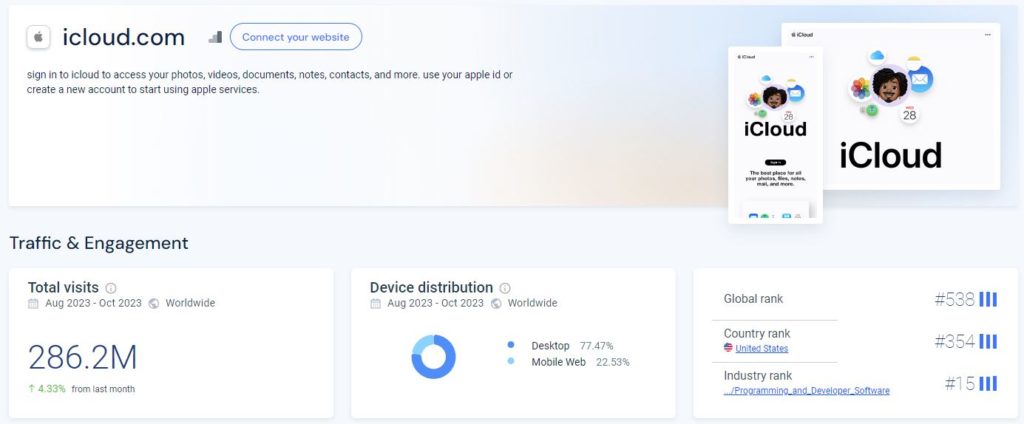
Is iCloud Good for SEO?
When we talk about SEO, we’re diving into the world of enhancing a website’s visibility on search engines. It’s all about making sure your site pops up when people are searching for topics you’re an expert in. Now, let’s shift gears and talk about iCloud. Launched by Apple in 2011, iCloud is more than just cloud storage and computing service. It’s a platform known for its seamless integration with Apple’s ecosystem, making file sharing and data backup a breeze for its users. While it primarily caters to Apple product users, its influence extends beyond, thanks to its high domain authority and widespread use.
| Website: | icloud.com |
| Founded: | 2011 |
| Type of Platform: | Cloud Storage and Cloud Computing |
| Key Features: | Key-value storage, document storage, and iCloud Backup |
| Content Types: | Documents, photos, videos |
| Popular Content: | Documents, photos, videos |
| Target Audience: | Individuals, businesses, and developers looking for secure and seamless cloud storage and synchronization services |
| Domain Authority: | 90/100 |
Most importantly, iCloud is renowned for its user-friendly interface and security features. It’s a go-to for people looking to store photos, documents, and more. But here’s the kicker for SEO enthusiasts: the type of content popular on iCloud usually revolves around personal storage rather than public content sharing. This means, while it’s a giant in the cloud storage world, its direct impact on SEO is a bit complex.

So, when considering iCloud for SEO, think about its high domain authority. Websites with high authority are like gold in the SEO universe – they have the power to boost your site’s credibility. However, the key lies in understanding the nature of iCloud’s platform, which is not primarily designed for public link sharing or content distribution. Therefore, leveraging iCloud for SEO requires a creative and indirect approach, focusing more on the credibility and authority aspects rather than traditional link-building strategies.
Are iCloud Links Nofollow or Dofollow?
The short answer? It’s complicated. Before diving into the iCloud link specifics, let’s break down what “Nofollow” and “Dofollow” links are. In the SEO world, these terms are crucial. Dofollow links are like glowing endorsements for your website. They tell search engines, “Hey, this site is worth checking out!” On the other hand, Nofollow links are more like casual mentions without any SEO weight. They say to search engines, “This link is here, but don’t count it as an endorsement.”
Now, onto the big question about iCloud links. Here’s the deal: iCloud, being a cloud storage service, primarily focuses on personal data security and storage. The platform isn’t typically used for creating publicly accessible content that would generate backlinks as a regular website or blog does. Therefore, the concept of Nofollow or Dofollow doesn’t quite apply in the traditional sense as iCloud isn’t a typical platform for content distribution or link-building.
In summary, while iCloud isn’t the typical ground for backlink strategies, understanding the nature of links is still a valuable skill in your SEO toolbox.
How Do I Add a Backlink to iCloud?
Let’s start with the basics: a backlink is essentially a digital nod from one website to another. Imagine it as one website saying, “Hey, check out this link for more info.” These backlinks are vital in SEO as they signal to search engines the credibility and relevance of your content. Now, let’s navigate the waters of adding a backlink to iCloud.
Here’s where it gets interesting. Typically, iCloud is used for storing and sharing personal files, not for creating content that others would link to in the traditional sense. However, if you’re looking to incorporate iCloud into your backlink strategy, it’s more about creative thinking rather than a straightforward process.
The Steps to Add a Backlink
- Create Shareable iCloud Content: First, you’ll need something worth linking to. This could be a public document or file hosted on iCloud that offers value, like a unique infographic, a helpful guide, or an innovative presentation.
- Ensure Public Accessibility: Make sure your iCloud content is set to ‘Public.’ Go to your iCloud Drive, right-click on the file, and choose ‘Share.’ Select ‘Add People,’ and then choose ‘Copy Link.’ Set the permissions to ‘Anyone with the link.’
- Craft Your Linking Strategy: Once your iCloud content is ready and accessible, it’s time to integrate this link into your broader digital content strategy. This could be through your website, blog posts, or social media platforms. Remember, the key here is relevance and context. The link should fit naturally within your content and offer real value to your audience.
- Monitor and Adapt: After you’ve set up your backlink, keep an eye on how it performs. Use analytics tools to track how users are interacting with your link. This data can provide insights for future content and backlink strategies.
Remember, while iCloud might not be the traditional route for backlinking, it offers a unique angle. It’s about thinking outside the box and finding innovative ways to integrate different platforms into your SEO strategy.
Best Practices for Posting on iCloud
Navigating iCloud for posting requires a blend of savvy and strategy. While it’s primarily a platform for personal storage, there’s still room for smart content sharing. Here’s how you can do it right.
The Do’s and Don’ts to Posting on iCloud
Do’s:
- Optimize File Formats: Ensure your files are in widely-used formats. Whether it’s a PDF for documents or JPEG for images, compatibility is key. This makes it easier for others to access and view your content.
- Maintain Organization: Use clear, descriptive file names and organize your content in well-structured folders. It’s not just about making it easier for others to find what they need; it’s also about presenting your content in a professional way.
- Prioritize Security: Even when sharing publicly, be mindful of the privacy settings. Avoid sharing sensitive or personal information. iCloud is secure, but it’s always best to err on the side of caution.
- Update Regularly: Keep your iCloud content fresh and up-to-date. Whether it’s tweaking a document or updating a shared folder, regular maintenance ensures your content remains relevant and useful.
Don’ts:
- Overload with Irrelevant Content: Avoid cluttering your iCloud with unnecessary files. Keep your shared content focused and relevant to your audience’s interests.
- Neglect Copyrights: Always respect copyright laws. Only share content that you have the rights to or is in the public domain. Remember, legality is paramount in content sharing.
- Ignore User Feedback: If you’re sharing content that others will use, be open to their feedback. It’s a great way to improve and make your content more valuable.
- Forget About Accessibility: Make your content accessible to all users, including those with disabilities. This could mean adding alt text to images or providing text-based versions of visual content.
Remember, while iCloud may not be your typical content-sharing platform, like Medium or YouTube, these best practices ensure you use it effectively and responsibly. It’s all about leveraging its strengths while staying mindful of its primary function as a secure storage service.
Does AmpiFire Submit to iCloud?
AmpiFire does not submit content directly to iCloud. When it comes to AmpiFire and its relationship with iCloud, it’s important to understand the nature of both platforms. AmpiFire is a content amplification platform, known for its ability to distribute and advertise content across various online channels. However, as iCloud primarily functions as a cloud storage service, it doesn’t align with AmpiFire’s typical distribution channels.

Now, let’s delve into how AmpiFire operates, to give you a clearer picture:
- Wide Distribution Network: AmpiFire excels in spreading your content across a vast array of platforms. This includes news sites, blogs, podcasts, and video platforms. It’s about casting a wide net to maximize your online presence.
- Content Amplification: The platform doesn’t just distribute content; it amplifies it. By creating diverse content formats like articles, blog posts, videos, and infographics, AmpiFire ensures that your message resonates with a broad audience.
- User-Friendly Interface: Ease of use is a big part of AmpiFire’s appeal. The platform is designed to be accessible even for those who aren’t tech-savvy, making it easier for a wide range of users to enhance their online marketing efforts.
In conclusion, while AmpiFire is a powerful tool for content distribution and amplification, its scope does not extend to submitting content to iCloud, given the distinct nature and purpose of the iCloud platform.
Get organic results with distribution tailored to you.
Discover AmpiFire and get your press releases be seen on Google News, YouTube, SlideShare, Apple Podcasts and many more…
Click Here To Learn More
Wondering how to elevate your online presence? Dive into the world of content amplification and SEO strategy. What’s your next digital move going to be?
Frequently Asked Questions
Absolutely, iCloud’s high domain authority can be a game-changer for SEO. Although it’s not a typical platform for content distribution, its credibility can significantly boost your site’s image in the digital world.
iCloud links, by their nature, don’t fall into the usual Nofollow or Dofollow categories. But remember, iCloud’s primary role isn’t about link building; it’s more about secure data storage.
While iCloud isn’t designed for traditional backlinking, with some creativity, you can integrate iCloud content into your SEO strategy. It’s all about thinking outside the box.
Certainly! iCloud demands a different approach than other platforms. Focus on file format optimization, organized content, and security. Unlike platforms like Google Drive or Dropbox, iCloud is more about personal storage, so tailor your strategy accordingly.
AmpiFire excels in distributing content across a wide range of platforms, unlike iCloud, which is more storage-focused. AmpiFire’s strength lies in its ability to amplify content, boost SEO, and its user-friendly interface.
It depends on your goals. For broader content distribution and SEO enhancement, AmpiFire is your go-to. If your focus is on leveraging high domain authority and secure storage, iCloud plays a role. Each has its unique advantages.
